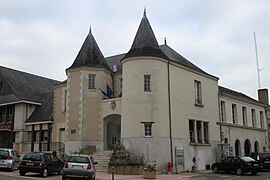Doué-la-Fontaine
| Doué-la-Fontaine | |
|---|---|

The town hall of Doué-la-Fontaine
|
|
| Coordinates: 47°11′38″N 0°16′28″W / 47.1939°N 0.2744°WCoordinates: 47°11′38″N 0°16′28″W / 47.1939°N 0.2744°W | |
| Country | France |
| Region | Pays de la Loire |
| Department | Maine-et-Loire |
| Arrondissement | Saumur |
| Canton | Doué-la-Fontaine |
| Area1 | 35.9 km2 (13.9 sq mi) |
| Population (1999)2 | 7,450 |
| • Density | 210/km2 (540/sq mi) |
| Time zone | CET (UTC+1) |
| • Summer (DST) | CEST (UTC+2) |
| INSEE/Postal code | 49125 /49700 |
| Elevation | 48–105 m (157–344 ft) (avg. 76 m or 249 ft) |
|
1 French Land Register data, which excludes lakes, ponds, glaciers > 1 km² (0.386 sq mi or 247 acres) and river estuaries. 2Population without double counting: residents of multiple communes (e.g., students and military personnel) only counted once. |
|
1 French Land Register data, which excludes lakes, ponds, glaciers > 1 km² (0.386 sq mi or 247 acres) and river estuaries.
Doué-la-Fontaine is a former commune in the Maine-et-Loire department in western France. On 30 December 2016, it was merged into the new commune Doué-en-Anjou. It is located in the heart of Anjou, a few kilometres from the great châteaux of the Loire Valley.
The town was already Vetus Doadum ("Old Doadum"), Teotuadum castrum, in Late Antiquity, identifiable in a document of 631 as Castrum Doe. The foundations of a 6th-century circular baptistery beside the natural springs has been uncovered beneath the ruins of the pre-Romanesque church of Saint-Léger, itself destroyed in the 17th century. It was the site of a Gallo-Roman villa that was inherited by the Carolingians. In his villa here, Theoduadum palatium, Louis the Pious was informed of the death of his father Charlemagne in 814 and hurried to Aachen to be crowned. The villa was turned into a motte in the 10th century, around which the village developed, in part in excavated troglodyte dwellings. In 1055 the site was identified as Doedus, then Docium in 1177.
Doué-la-Fontaine is the site of the oldest habitable donjon (keep) in France, dating back to the year 900. No traces of Doué's medieval fortifications remain, save the names of "gates" given to certain streets. The castle is widely believed to have been the first European castle to be built out of stone (at around 950).
...
Wikipedia


